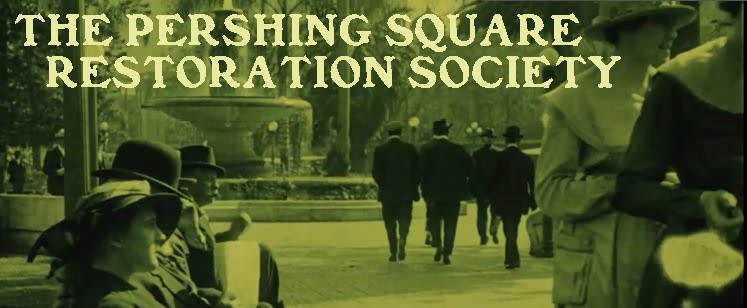Many people today are unaware that Veterans Day was once
Armistice Day and commemorated the end of the First World War. Likewise as
residents of Los Angeles take in events at Pershing Square, few realize it is
in fact a memorial to that war. As
mentioned in a previous blog post, although
the park dates back to the 1870s, it was the first memorial to the Great War in
the City of Angels and was arguably the center for civic events to honor
Angelenos who served. As time passes and
developers and
preservationists alike
make cases for their version of the park space, I think it's once again
important to highlight this connection as the centenary of WWI is upon us.
Mayor Meredith "Pinky" Snyder was a colorful man. He
moved to California when he was 22 with five bucks in his pocket. He soon got
involved in real estate, started a shoe company, and promoted a menagerie of
other businesses over the decades. Snyder at times dipped his toes into public
service, as Los Angeles Police Commissioner and on the State Industrial
Accident Commission. He would be elected mayor of Los Angeles three separate
times. In between one of these periods, he was arrested when his chauffeur
broke the 12 MPH downtown speed limit. Snyder happily paid the fine, commending
the officers for their "brilliant execution of duty." He seems to
have been a beloved public servant, and was laid in state at City Hall after
his death in 1937.
One might guess that much of Meredith Snyder's public
service in the last two decades of his life was done to take his mind off the
loss of his son, Ross. The younger Snyder was a Captain and a war hero who died
in France. He received the
Silver Star posthumously.
His citation read in part:
“Captain Snyder distinguished himself by gallantry in action
while serving with the 47th Infantry Regiment, 4th Division, A.E.F., in action
near Sergy, France, 29-30 July 1918. Captain Snyder commanded the 3d Battalion
under heavy enemy artillery and machine gun fire after three of the battalion
commanders had become casualties. He reorganized this battalion and directed
its movements in the attack, constantly exposing himself until he was killed by
enemy machine gun fire.”
 |
| Ross Snyder, courtesy Harvard-Westlake School |
Like thousands of American families, Meredith and May Snyder
had to decide whether to ask for their son's remains to be brought home.
Initially, Ross was left overseas (because of where he fell, it is likely he
was interred at what is now Oise-Aisne American Cemetery). His name was also inscribed
on the D.A.R. tablet in Victory Memorial Grove in Elysian Park and given to the
park in South Los Angeles that bears his name to this day.
In 1923, the Snyder family asked for their son to be exhumed
and returned stateside. Immediately, the city decided to spare no expense in
honoring its son. Like
Morris Lynchik's service two years previous, this
one would be held in Pershing Square.

Arrangements began in late September. Ross Snyder lay in
state in the park for 24 hours from September 27-28 for mourners to pay their
respects.
The Los Angeles Times did not estimate the size of the crowd that
viewed the body, but it was unquestionably large. Reverend W. E. Edmondson, a
former State Chaplain of the American Legion, led the afternoon service on the
28th honoring Captain Snyder. In what was described as "one of the most
impressive and one of the largest ever held in Los Angeles," the funeral
cortege made its way from downtown to Hollywood Cemetery (now Hollywood
Forever).
Among the procession would be commanders of multiple American Legion
and VFW posts (as well as the members themselves), students of the Harvard
Military School (Ross Snyder was an alum), former soldiers from the 4th
Division veterans of the Spanish American and Civil wars, numerous veterans of
allied countries, as well as friends and family. As the sun descended over the
city, three volleys were fired, and “Taps” was played by a war buddy.
 |
| photograph by AJ Marik, Find A Grave |
To my knowledge, only two US servicemen, Ross Snyder and
Morris Lynchik, were ever given the honor of having part of their funeral
services open to the entire city. Both services were held in our beloved
Pershing Square.
Though some would like to remake the place and ignore its
bones, this park has a history like no other—if one only seeks to look. Today,
Pershing Square is many things to many, many people. It is widely criticized by
most. To some, it is a place for civil discourse with their friends. To others,
a place to eat lunch away from work, watch a movie in the summer, or to ice
skate during the winter.
Some, like myself, hope for the day its lost history and
memories are rediscovered by everyone.
 |
| Ross Snyder (bottom center), courtesy Harvard-Westlake School |
___
COURTLAND JINDRA is an amateur historian and volunteer for the United States World War I Centennial Commission.
His "Great War" interest is largely focused on America's contribution
to and remembrance of it. Delving into Los Angeles Times' archives,
Jindra has located numerous memorials to the war in L.A. County, the
first of which being the renaming of "Central Park" as "Pershing Square"
in November 1918. He is a passionate advocate for highlighting their
importance, and through them the war effort writ large.







